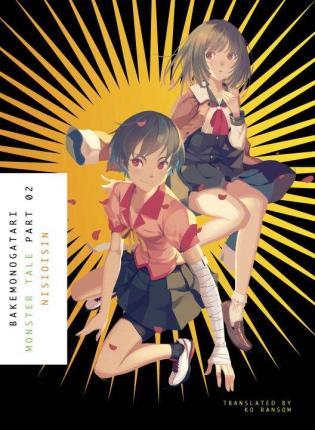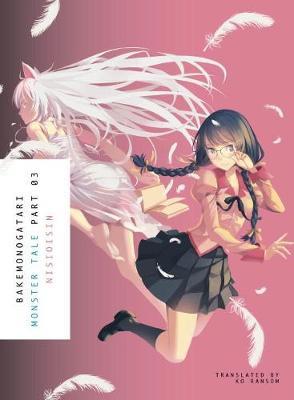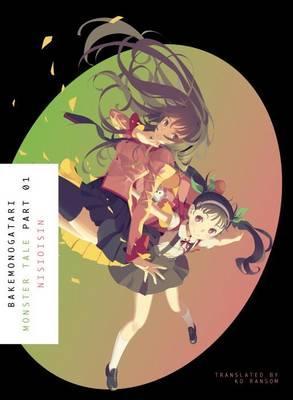Bakemonogatari Parts 1 – 3 Review
Monogatari is a series that, as a whole, largely passed me by, because I watched a couple of episodes of Bakemonogatari a few years ago and couldn’t get into it. However, last year I had the chance to watch Kizumonogatari at the Leeds Film Festival, and since then I’ve gone on to read the Kizumonogatari light novel and all of Bakemonogatari. With my newfound interest in the series, I want to tell you why it’s well worth giving the books a chance.
Bakemonogatari follows the story of Araragi Koyomi, a third year high-school student who just happens to be part vampire. Well, to say he’s part vampire is slightly inaccurate as he’s actually 90% human (or thereabouts anyway), but I won’t say more than that because Kizumonogatari explains why he’s this way. Araragi goes about his days peacefully until he suddenly saves a female third-year, Hitagi Senjougahara, from falling down a flight of stairs. To his surprise, Hitagi feels as light as a feather – almost like she weighs nothing at all. Araragi inquires about the girl with his class president and only friend, Tsubasa Hanekawa, who tells him that Hitagi suffers from a rare illness. For most people this might be where the story comes to an end, but for Araragi, who has experience with the abnormal, it’s just the beginning…
It turns out that the illness Hitagi experiences is not something that can be cured through regular medical means – in fact, doctors have pretty much given up hope. Hitagi is frustrated that Araragi has discovered her illness and goes on a rampage, which includes attacking Araragi with a stapler, but Araragi refuses to give up on the girl. After she calms down, Hitagi reveals that the fact she has no weight is because of a crab – not an ordinary crab, but something mysterious and more fantastical. Having dealt with vampires previously, and being partly one himself, Araragi is no stranger to the weird and wonderful, and vows to find a way to solve Hitagi’s problem – but even once he achieves that, will mysterious problems ever leave him alone?

Araragi never finds himself far from a girl with some kind of odd problem. Over the course of the three Bakemonogatari volumes there are four girls that Araragi sets out to help and all of them then become recurring characters going forward. However, while Bakemonogatari sets itself up as a harem series, it also puts into motion events to prevent falling into the usual harem tropes.
Araragi and Hitagi start dating during the first volume, which is a simple but effective move. It ties up Araragi enough that the other girls respect he’s not theirs for the taking, and it also opens up an interesting dynamic between him and Hitagi. It’s something that few series like this would usually do, and I find myself with a lot more respect for Monogatari because of it.
None of what I’ve said so far is where Bakemonogatari truly excels though – because the best part about this series is actually the witty dialogue between the cast members. Series author NISIOISIN has a charm to his writing that really grips you as a reader and captures you in the story. For all three volumes of Bakemonogatari I feel like very little actually happens – solving a character’s problems usually takes no time at all. This series is really all about Araragi and the interactions he has with those around him. The dialogue is filled with humorous puns, references and witty comebacks, the likes of which I’ve never seen in any other light novel to date. It also has to be said that series translator Ko Ransom (and publisher Vertical) have done an incredible job of bringing these works into English and ensuring they still have the same level of quality as they do in Japan. That said, if you’re someone who prefers an action-driven plot, then this definitely isn’t the series for you.

Illustrations for the series have been handled by VOFAN, an illustrator from Taiwan. Each volume of Bakemonogatari opens with a colour page, but beyond that illustrations are only used for the beginning of each girl’s story. While that means I can count the number of pictures between these three books on one hand, it does mean I appreciate the artwork that is on show all the more.
The Monogatari series is being brought to the UK thanks to Vertical. Interestingly, for Bakemonogatari they broke the books up into three volumes rather than keeping it two volumes as it was in Japan. This means that the third volume begins in a slightly awkward point (insofar as the first half ends up being unrelated to the main story being told), but the three volume release works well overall. I think the second volume would have been incredibly overwhelming for some readers if Vertical had stuck with only two books.
It has to be said that I am not a fan of the Monogatari anime – I found it a real struggle to get into and so never did, but I have been pleasantly surprised by the light novels. Bakemonogatari, and Kizumonogatari before it, have warmed my heart to this fascinating series and the stories Monogatari has on offer. This series is nothing if not unique, and if you’re looking for something different to your average light novel affair, then you need look no further.


